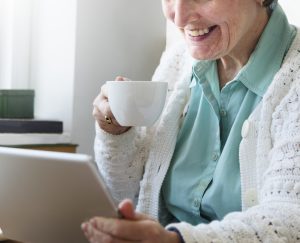 As the days get shorter in the fall and winter, some people experience what is known as seasonal affective disorder (SAD). SAD is a form of depression that can cause depressed mood and low energy level. More than just the “winter blues,” SAD is a serious condition that should be identified and addressed. Consequently, at our skilled nursing community in Fort Collins, we reassure residents that there are steps that can be taken to treat SAD.
As the days get shorter in the fall and winter, some people experience what is known as seasonal affective disorder (SAD). SAD is a form of depression that can cause depressed mood and low energy level. More than just the “winter blues,” SAD is a serious condition that should be identified and addressed. Consequently, at our skilled nursing community in Fort Collins, we reassure residents that there are steps that can be taken to treat SAD.
While doctors and researchers don’t fully understand SAD, the condition is clearly caused by decreased exposure to sunlight and seems to affect hormone levels and our internal clock to a degree. And, in addition to mood and energy level issues, SAD can also be responsible for:
It’s important to note that other conditions can cause many of these symptoms. So, it’s critical to talk with your doctor who can help you identify exactly what is causing them.
Doctors commonly prescribe two treatments for SAD. First of all, bright light therapy uses special fixtures that produce high intensity light. They can help decrease melatonin production, leaving you feeling less sleepy and depressed. In addition, a treatment called cognitive behavioral therapy can be used. Also referred to as “talk therapy,” it teaches you to reduce negative thoughts and mindsets so you can deal more effectively with the decrease in sunlight.
Other things you can do at your skilled nursing community to help minimize SAD include:
As a leading provider of skilled nursing in Fort Collins, Colorado, we want all our residents at Green House Homes at Mirasol to stay happy and healthy through the winter and year ‘round. Therefore, we encourage them to take action promptly if they begin to feel the effects of seasonal affective disorder. Because the condition can be successfully treated, there is no need to suffer until springtime.
 Colder weather is coming, and with it cold and flu season. Not only can catching a bug put you out of commission for a few days, it can lead to complications in some cases. But, in your senior housing community and around town there are things you can do to help minimize the risk of getting sick.
Colder weather is coming, and with it cold and flu season. Not only can catching a bug put you out of commission for a few days, it can lead to complications in some cases. But, in your senior housing community and around town there are things you can do to help minimize the risk of getting sick.
As a leading senior housing provider, we know from experience that you can use these simple strategies to stay healthy this cold and flu season:
At the Green House Homes at Mirasol senior living community in Fort Collins, we do all we can to help our elders avoid illness all year long, and especially during cold and flu season. It’s a collaborative effort, and one that pays off with better health and happiness!
Injuries suffered due to falls are some of the biggest health risks to elders, at home or in a skilled nursing facility. From broken bones to head trauma, falls can cause significant pain and suffering, hospitalization, and subsequent complications. Fortunately, there are ways to minimize the risk of falls. At Green House Homes at Mirasol, we act on all of them to help keep elders safe.

There are many environmental and health conditions that can make it more likely that an elder will suffer a fall. However, caregivers can address each so that the risk is minimized. Here are some of the ways that loved ones at home or skilled nursing providers can help keep elders safe:
Elders in skilled nursing communities rely on their care providers to watch out for them. At Green House Homes at Mirasol, ensuring the safety and wellness of those we care for is our top priority. Consequently, we do all we can to minimize fall risks so that they can move about freely and their families can have peace of mind.
Preparing to move into senior housing can be both a very exciting time and a somewhat stressful one. An elder is likely to feel eager to make new friends. But, they may also be sad to be saying goodbye to familiar surroundings and routines. In order to make a smooth transition to the new living situation, there are a number of steps that can be taken.
 Focusing on the Future
Focusing on the Future
Here are some strategies that elders and their families can use to prepare for a move and approach it with optimism:
Start connecting before you move in
There’s no reason to wait until after you’ve moved in to start connecting with the other elders you’ll be living with. Once you’ve signed your paperwork, ask if you can begin attending meetings and social events.
Plan family visits
Having loved ones come check out your new home can be uplifting for you and fun for them. And knowing that you’ve already put those visits on the calendar gives you something to look forward to. If you have lots of family and friends in the area, it may be wise to spread those visits out. Have people come over a period of weeks rather than bunching visits together.
Begin downsizing early
A move to a senior housing environment may mean that some of the elder’s accumulated belongings will need to be given new life through donation or discarded. Rushing to make these kinds of decisions ahead of a fast-approaching moving day can be stressful. Instead, try to start making those choices as far in advance as possible so that you can tackle them gradually.
Ask for assistance from a third party
When thinking about what to do with personal possessions, it can help to have a friend or relative provide their input. As someone a little removed from this emotional process, they will have a more objective perspective.
Get involved immediately
It’s understandable that you might want to “ease into” your new living situation. But, the more involved you are in activities at your new home, the more connected you’ll feel. Join a club, volunteer to help with tasks, sign up for an outing. All of these things help you make and maintain strong friendships.
At Green House Homes at Mirasol, our senior living environment is designed to make the elders who are joining us feel welcome, cared for, and connected. It’s our view that the transition from their previous living situation can be one that is easy and enjoyable, and we do all we can to support that.
When we think about the importance of staying healthy, we tend to focus on physical health, with eating well and getting plenty of exercise at the top of our list. However, it’s important that we pay attention to our mental and emotional health as well. Chronic stress can have a very negative impact on the way we think and feel. What’s more, it can cause physical harm or make existing ailments worse. That’s why it’s important to know how to minimize stress and to use those techniques regularly to maintain a more relaxed and positive outlook.

While everyone experiences times of stress, there are things you can do to help prevent or alleviate it, including:
Our approach to life at Green House Homes at Mirasol is helping elders stay engaged, active, and interested in playing a role in how their house operates. It’s a unique perspective on skilled nursing, but our elders find it to be one of fulfillment, happiness, and less stress. And, it leaves their loved ones feeling the same way.